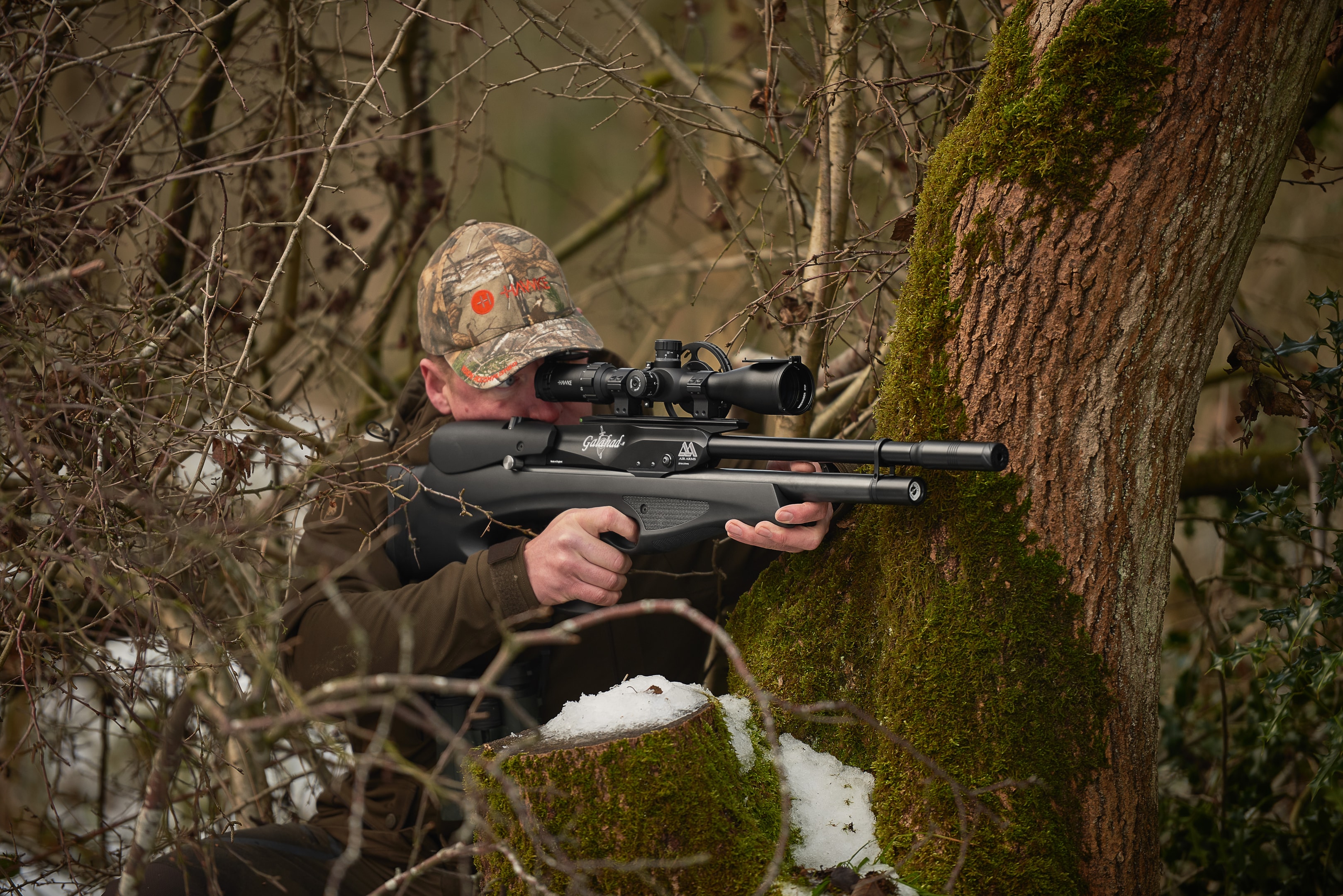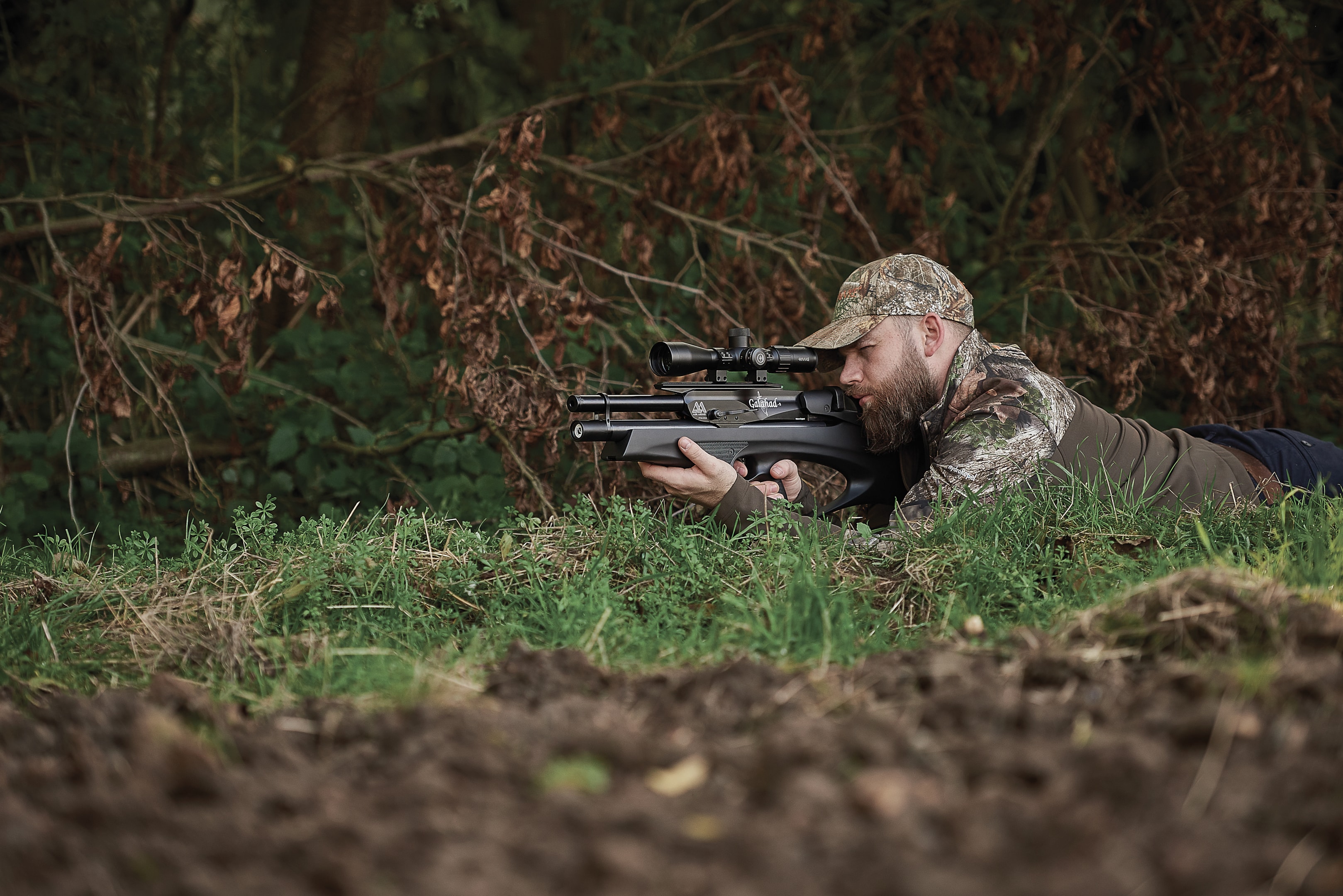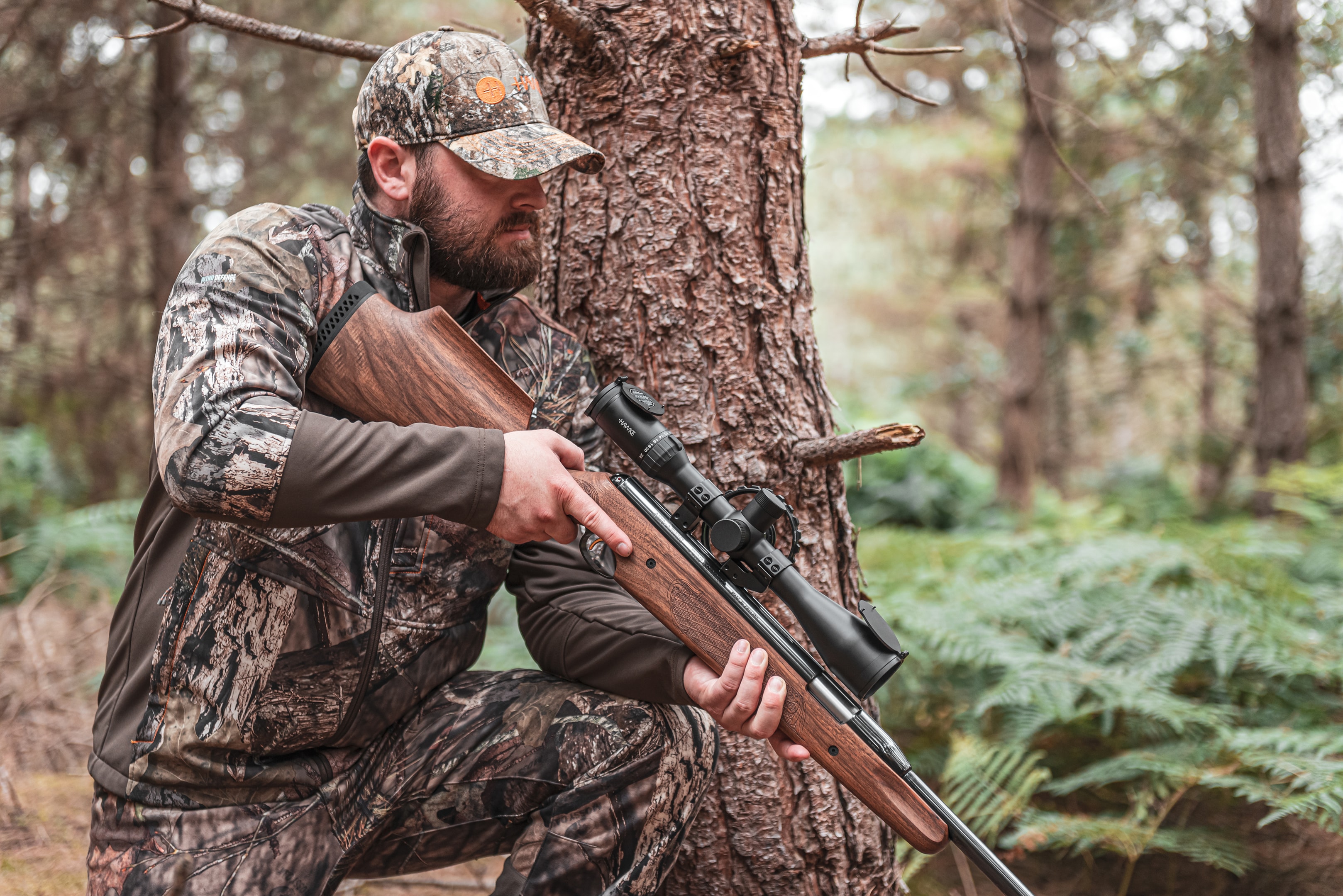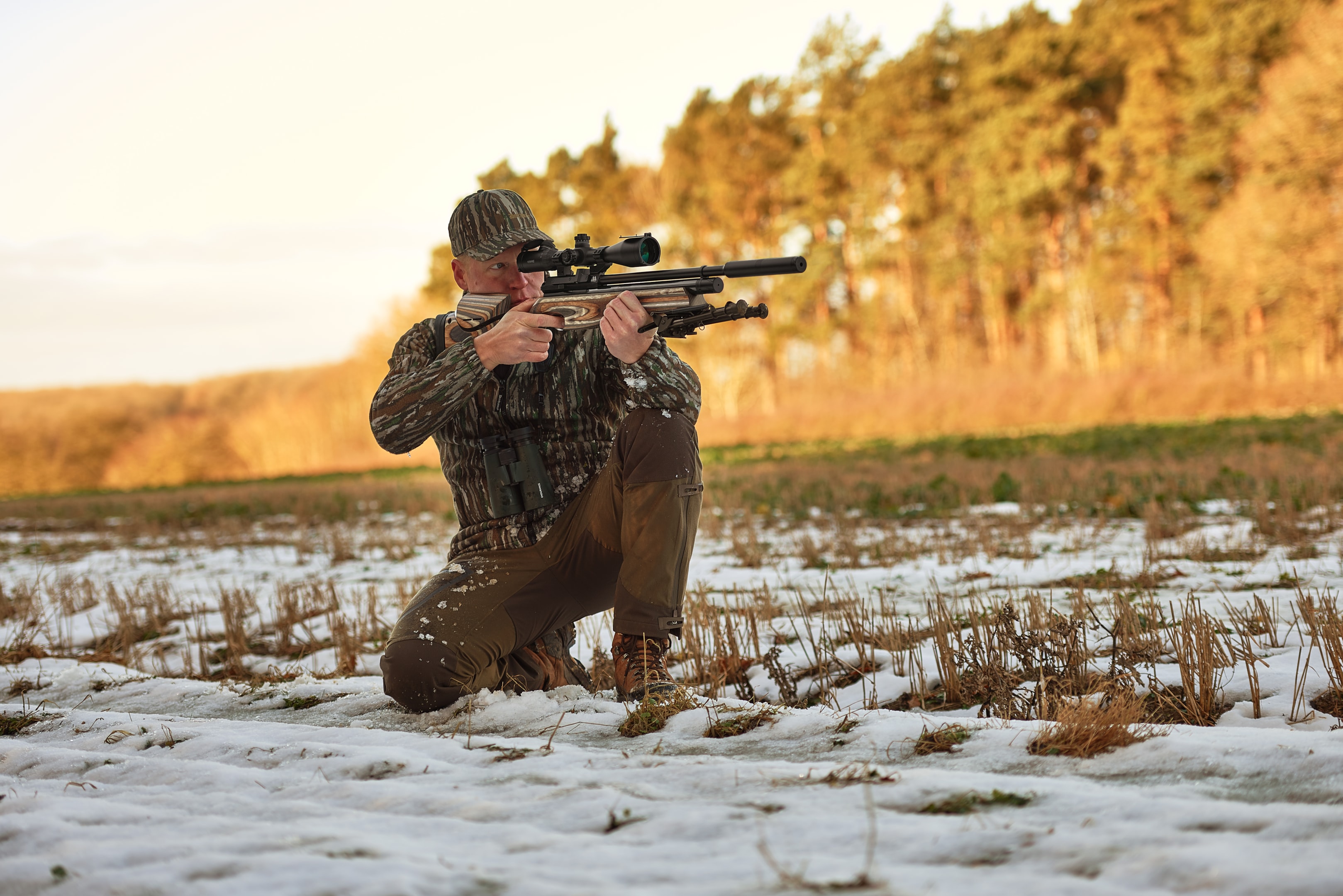How to Shoot an Air Rifle More Accurately: A Beginner’s Guide
15 November 2024 | Air Arms

From their accessibility and ease of use to their versatility and widespread community, air rifles have been and continue to be a growing sport worldwide. However, there is more to air rifles than just pointing and shooting, and if you want to enhance your shooting and accuracy skills, you've clicked on the right page.
In this article, we will take a look at how to set up your rifle, master proper head and cheek positioning, and adjust for external influences. Whether you’re picking up an air rifle for the first time or seeking to refine your skills, this guide will provide the foundational knowledge you need to shoot more accurately.
Understanding your rifle
First, you must understand your rifle. Determine what type of power your air gun has (PCP air rifles, Spring air rifles, Gas Ram, etc) and make sure you're familiar with the mechanics and build. Find the best air rifle for you and familiarise yourself with its unique characteristics and mechanics.

Types of Air Rifles
PCP Air Rifles: These rifles are powered by compressed air stored in a cylinder. They are known for their consistent power output and smooth shooting experience, making them popular for those seeking precision. PCP rifles usually require a pump or a scuba tank to refill the air cylinder, so understanding the refilling process is crucial.
Spring Air Rifles: These rely on a coiled spring and piston mechanism. When the trigger is pulled, the spring propels the piston forward, compressing air and firing the pellet. These rifles are valued for their simplicity and reliability, though they can require more skill to handle due to the recoil generated by the spring mechanism.
Gas Ram Air Rifles: Similar in function to spring rifles, Gas Ram air rifles use a gas-filled cylinder instead of a spring. This provides a smoother shooting cycle with less vibration and recoil, often resulting in improved accuracy and a quieter shot.
Familiarising with Your Rifle
Understanding your rifle's build and mechanics is essential to maximising its performance—and ultimately, its accuracy performance.
Read the Manual: The user manual is a comprehensive guide to your air rifle's specifications, maintenance procedures, and safety precautions. It’s your first port of call to understand your rifle's operation.
Practice Handling: Spend time handling your rifle to get familiar with its weight distribution, balance, and ergonomics. This will help you develop the muscle memory needed for consistent shooting.
Understand the Trigger Mechanism: The trigger is critical to shot accuracy. Practice dry firing (where possible and safe) to get a feel for the trigger pull and reset. This practice can improve your control and timing.
Regular Maintenance: Keeping your rifle clean and well-maintained is vital for optimal performance. Follow the manual's guidelines for cleaning and lubricating the moving parts to ensure smooth operation.
By understanding the specific characteristics of your air rifle and how its build affects performance, you can tailor your shooting techniques and maintenance practices to suit your equipment. You can learn more about these types of air rifles in our article 'What is an air rifle?'

So, how do you shoot more accurately?
Shooting an air rifle accurately, no matter what type you have, involves a combination of proper technique, practice, and understanding of your equipment. Whether you're target shooting or dealing with pest control, you can look at our beginner's guide to have the best foot forward with your accuracy skills.
1) Your Stance and Grip
Stability and Balance: A proper stance provides a stable foundation, helping you maintain balance and control over the rifle. This stability is essential for consistent shooting, especially when aiming at a target for extended periods.
Recoil Management: Although air rifles have less recoil than firearms, managing even slight recoil is essential for accuracy. A good stance helps absorb and manage this recoil, preventing it from affecting your aim.
Consistency: Both stance and grip contribute to shooting consistency. Maintaining the same stance and grip for each shot reduces variables affecting accuracy, leading to more predictable and reliable shooting results.
Precision and Control: A proper grip ensures that you have precise control over the rifle, allowing for smooth trigger pulls and minimising movement that could disrupt your aim.
Muscle Memory: Practicing a consistent stance and grip helps develop muscle memory, making it easier to replicate the same shooting form each time. This repetition is critical to improving accuracy over time.
Comfort and Endurance: A comfortable stance and grip allow you to shoot for extended periods without fatigue, which is vital for practice sessions and competitions.
2. Breathing Control
Take a deep breath, exhale halfway, and hold your breath while you take the shot. This helps minimise body movement.
Breathing control is critical to shooting accuracy because it helps minimise body movement, which can affect your aim.
Minimising Movement: Breathing naturally causes your chest to rise and fall, leading to slight movements in your body and, consequently, the rifle. Holding your breath reduces these movements, allowing for a steadier aim.
Timing and Focus: Controlling your breath helps you focus and precisely time your shot. It creates a moment of stillness, allowing you to concentrate fully on your target and the trigger pull.
Reducing Tension: Exhaling halfway before holding your breath helps prevent tension from building up in your body. Holding a full breath can cause strain, leading to shaking or discomfort, negatively impacting your shot.
Consistency: Using a consistent breathing technique helps you develop a routine, making replicating the same conditions for each shot easier. This consistency is vital to improving accuracy over time.

3. Trigger Control
Squeeze, Don’t Pull. Gently squeeze the trigger with the pad of your index finger. Avoid jerking or pulling the trigger, which can move the rifle and affect accuracy.
Trigger control is essential for shooting accuracy because it directly affects the rifle's stability at the moment of firing. Here's why gently squeezing the trigger, rather than pulling or jerking it, is essential:
Minimising Movement: Jerking or pulling the trigger can cause the rifle to move abruptly, shifting your aim and leading to inaccurate shots. A gentle squeeze helps maintain the rifle's alignment with the target.
Smooth Action: Squeezing the trigger smoothly allows the shot to break without disturbing your aim. This smooth action is crucial for maintaining control over the rifle and ensuring that the shot goes where you intend.
Consistent Pressure: Squeezing the trigger with the pad of your index finger helps apply consistent pressure. This consistency is essential for developing a reliable shooting technique, as it reduces variables affecting accuracy.
Focus and Control: A gentle squeeze requires focus and control, encouraging you to be more deliberate with each shot. This mindfulness can improve your overall shooting discipline and precision. Focusing on a smooth trigger squeeze can also reduce the tendency to anticipate the shot, which can cause flinching or other involuntary movements that disrupt accuracy.
4. Follow-Through
Maintain Position: Keep your position and aim at the target after firing. This helps ensure that movement doesn’t affect the shot as the pellet leaves the barrel. Follow-through is crucial to shooting accuracy because it ensures that your actions after firing do not inadvertently affect the shot.
Stability During Pellet Travel: Even after you pull the trigger, the pellet takes a brief moment to travel down the barrel and exit. Maintaining your position ensures that movement doesn't disrupt the rifle's alignment during this critical phase.
Consistency: Consistent follow-through helps reinforce good shooting habits. Maintaining your position creates a routine that can be replicated with each shot, contributing to overall accuracy.
Minimising Flinch: Follow-through helps reduce the tendency to flinch or move prematurely after firing. This discipline ensures that your body remains steady, preventing unintended movements that could affect the shot.
Feedback and Learning: By holding your position, you can better observe the shot's impact and gather feedback on your performance. This observation is valuable for making adjustments and improving your technique over time.
Confidence Building: Practicing follow-through builds confidence in your shooting abilities. Maintaining control and stability throughout the shooting process enhances your overall performance.
5. Sight Alignment
Use the Sights and align the front and rear sights properly. If using a scope, ensure it is adequately zeroed, and you have a clear picture.
Focus on the Target to ensure proper alignment; focus on the target, not the sights.
Sight alignment is fundamental to shooting accuracy because it ensures the rifle is appropriately aimed at the target. Here's why using the sights correctly and focusing on the target is essential:
Precision in Aiming: Proper alignment of the front and rear sights ensures that the rifle is aimed precisely at the target. Misalignment can cause shots to veer off course, leading to inaccuracy.
Scope Zeroing: If using a scope, ensuring it is adequately zeroed means that the point of aim matches the point of impact. This alignment is crucial for accuracy, especially at varying distances.
Clear Sight Picture: A clear sight picture lets you see the target and the properly related sights. This clarity is essential for accurate shots, as it helps you confirm that the rifle is aimed correctly.
Focus on the Target: Focusing on the target rather than the sights helps maintain situational awareness and ensures that your aim is directed where it needs to be. This focus also helps prevent tunnel vision on the sights, which can lead to misalignment.
Reducing Parallax Error: Focusing on the target minimises parallax error, which can occur when the eye is not perfectly aligned with the sights or scope. This error can cause the point of aim to shift, affecting accuracy.
6. Stay Consistent
Consistency in shooting technique is vital for improving accuracy because it reduces variables affecting your performance. Here's why repetition and regular practice are essential:
Building Muscle Memory: Repeating the same shooting technique helps develop muscle memory, allowing your body to perform the actions automatically. This automaticity leads to more consistent and reliable shooting as your body becomes accustomed to the correct form and movements.
Reducing Variables: Using the same technique every time minimises the number of variables that can affect your shots. Consistency in stance, grip, breathing, and trigger control ensures that each shot is as similar as possible to the last, making identifying and correcting any issues easier.
Improving Accuracy: Consistent practice helps refine your skills and improve accuracy over time. As you become more familiar with your technique, you can make subtle adjustments to enhance your performance and hit your target more reliably.
Confidence Building: Regular practice and a consistent technique build confidence in your shooting abilities. Knowing that you can replicate the same form and achieve similar results boosts your self-assurance and reduces anxiety during shooting.
Adaptability: Once you have mastered a consistent technique, you can more easily adapt to different shooting conditions or challenges. A strong foundation allows you to make necessary adjustments without compromising your overall performance.

What can affect your accuracy?
There are a couple of things outside of your technique that can affect your accuracy.
Equipment Maintenance
Equipment maintenance is crucial for ensuring optimal performance and accuracy in shooting. Regular maintenance preserves your gear's functionality and enhances range precision.
Ensuring Accuracy: Regularly cleaning the barrel removes any debris, residue, or fouling that can accumulate over time. This buildup can affect the pellet's path by causing friction or altering its trajectory, leading to inconsistent and inaccurate shots.
Preventing Corrosion: Cleaning the barrel helps prevent rust and corrosion, which can damage the interior surface. A well-maintained barrel ensures a smooth path for the pellet, maintaining the rifle's accuracy and longevity.
Consistent Performance: A clean barrel provides a consistent shooting environment, reducing the variables affecting performance. This consistency is critical to achieving reliable accuracy with each shot.
Safety: Regular maintenance, including cleaning the barrel, ensures the rifle operates safely. Debris or obstructions in the barrel can pose safety risks, potentially leading to malfunctions or accidents.
Environmental Considerations
Another variable you must remember when looking at your shooting accuracy (and shooting in general) is the weather conditions.
Wind and Weather
Wind Conditions: Wind is one of the most significant environmental factors affecting shooting accuracy. It can alter the trajectory of a pellet or bullet, especially over longer distances. You need to assess both the speed and direction of the wind to make necessary adjustments to their aim. This might involve aiming slightly upwind or adjusting the elevation to compensate for wind drift.
Weather Variability: Different weather conditions, such as rain, fog, or extreme temperatures, can also impact shooting. Rain and humidity can affect air density, altering the projectile's path. Cold weather can stiffen muscles and affect the shooter's grip and trigger control, while heat can cause mirage effects that distort the target's appearance.
Adapting Techniques: Experienced shooters develop techniques to adapt to varying weather conditions. This might include using wind flags or other indicators to gauge wind conditions or adjusting shooting positions to minimise the impact of adverse weather.
Lighting
Visibility: Good lighting is crucial for accurately seeing the target and aligning the sights. Poor lighting conditions can lead to distance and target size misjudgments, affecting accuracy. You should ensure that you have adequate light to see both the target and their sights.
Glare and Shadows: Bright sunlight can cause glare, while low light can create shadows that obscure the target. Both conditions can distort the shooter's perception and make it challenging to aim accurately.
Consistent Conditions: To develop a reliable shooting routine, practice shooting in consistent lighting conditions whenever possible. This consistency helps build confidence and accuracy as the shooter becomes accustomed to the visual environment.
Stress and Fatigue
Believe it or not, even your psychological and physical state can play crucial roles in shooting your air guns with accuracy. High stress and anxiety can disrupt concentration, leading to rushed and inaccurate shots, while physical and mental fatigue impairs focus and stability. This can lead to inconsistent breathing, and elevated heart rates can cause subtle movements that affect precision.
To manage these challenges, you can practice mindfulness and deep breathing and ensure adequate rest to enhance focus and maintain a steady aim.

Conclusion
In conclusion, mastering your accuracy involves technique, awareness, and practice. While maintaining a proper stance and grip can enhance your accuracy, remember that outside factors might also come into play.
Whether you're just interested in recreational shooting or small game hunting, practising regularly can hone your skills and build the confidence you need to excel in different shooting conditions. If you have any questions or queries, please do not hesitate to contact us - we can find the perfect air rifle for you and answer all your air gunning needs.





